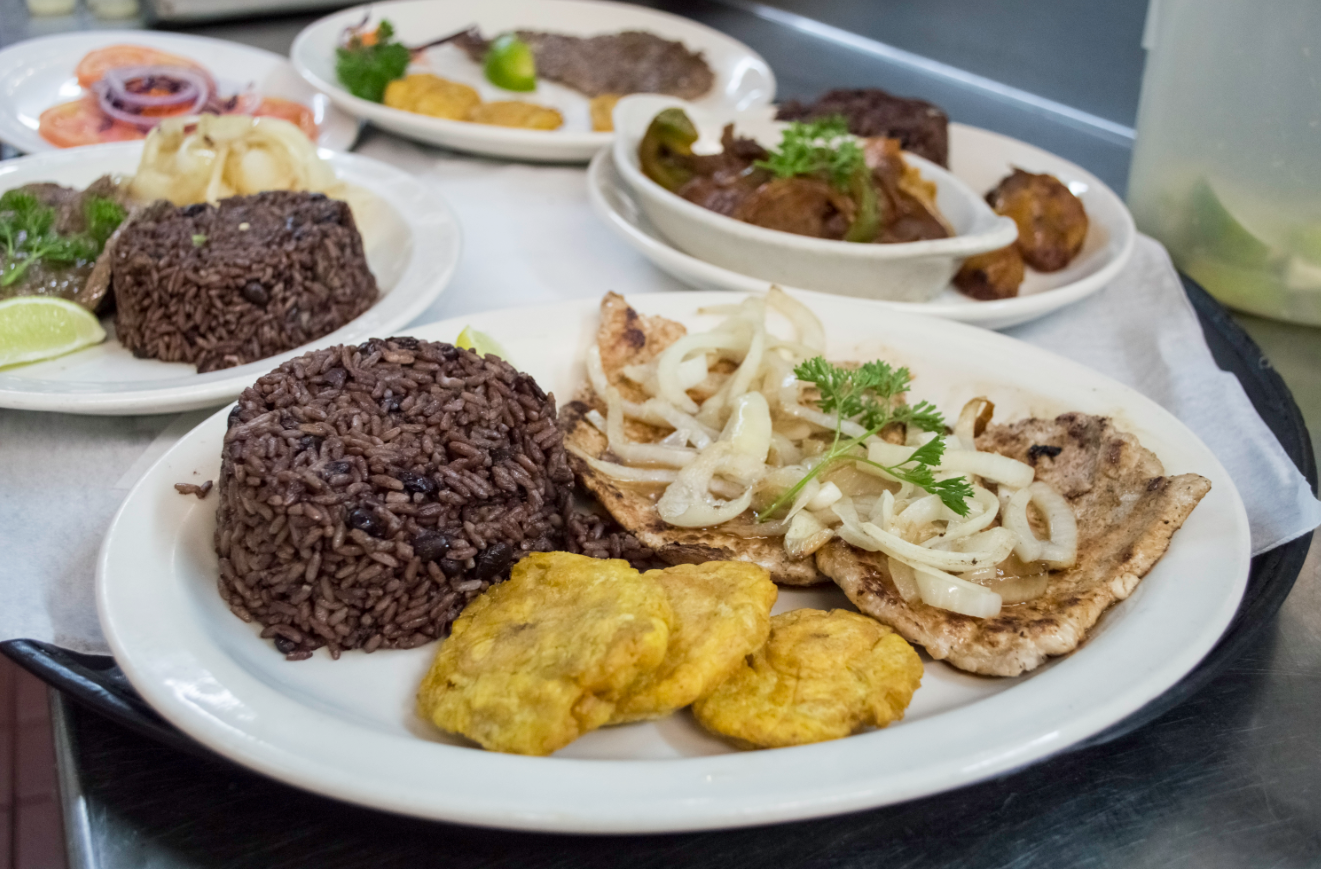
There’s nothing like savoring the tender juiciness of lechon asado or biting into the crunchy interior of a frita sandwich. Though these dishes are inherently Cuban, they’ve become closely associated with Miami.
Junior Jorge Alvarez is Cuban-American and cherishes the connection between food and his home country.
“In Miami, I think it just ties back to the Cuban roots that a lot of people left behind when they left the island,” he said.
So how did such a distinct, exotic cuisine, filled with a complex variety of textures and flavors, make its way to this burger-and-fries-loving land?
Philadelphia has its cheesesteaks and New York City has its bagels, but Miami’s food culture is less clear-cut. Its geographical proximity and similar climate to Latin American countries attracts immigrants from a variety of cultures, and each brings their own traditions and customs to the States.
Because Miami serves as a sort of gateway to America, its culture is a result of multiple influences that blend together to create the city’s unique identity.
In 1959, the rise of Fidel Castro led to a series of migrations that brought nearly one million and a half Cubans to the greater Miami area. Before these migrations, Little Havana, now considered Miami’s epicenter of Latin American cuisine, was divided into two neighborhoods: Riverside and Shenandoah. At the time, Bahamians made up most of that area’s population before transitioning to a largely Eastern European Jewish community.
But the waves of Cuban newcomers were attracted to the affordable neighborhoods, and they soon replaced this Jewish community. As more settled in the area, Cuban-style window-service restaurants and cafes began to emerge, and the two neighborhoods fused to become Little Havana.
Cubans lived peacefully alongside other cultures, yet maintained uniquely strong ties to their distinct identity, rather than assimilate into American culture.
According to Mandy Baca, Miami native and author of “The Sizzling History of Miami Cuisine,” this strength was a result of Cubans’ subconscious knowledge that they would not be returning home.
“This group’s coming was not like diasporas in other cities, where the groups quietly moved in and assimilated to the area,” Baca wrote in her book. “They knew that they would have to recreate another Cuba here.”
By the 1970s, the success of these communities was attracting even more immigrants, and Cubans had transformed Miami into a more Latin American-centric city. It was then that the now-iconic Versailles Restaurant opened.
Nicole Valls, granddaughter of founder Felipe Valls, Sr., said her grandfather got his start in the business by selling restaurant equipment. Wanting to emulate the walk-up coffee windows of his home country, Valls, Sr. convinced his boss to import espresso machines. This led to his opening of Versailles in 1971.
It began as a small sandwich spot with a walk-up coffee window, and, in the 43 years since its establishment, evolved into a 350-seat bakery and restaurant that serves more than 1,000 cafecitos a day.
Nicole said the restaurant’s transition from an eatery to a cultural icon was a gradual one.
Since the spot stayed open late, it attracted a wide variety of artists and visitors in its first two decades. Politicians and celebrities started stopping by, too, and this propelled Versailles’ popularity – turning it into a mecca of Cuban culture in Miami.
“It’s just become world famous, really,” Valls said. “This is where the media comes to get the pulse of Miami … it’s like a second home to people … it’s just so integral to Miami’s culture.”
In any Cuban restaurant, it’s clear that the cuisine has the power to engage more than just taste buds. The sense of community, comfort and love that fills these eateries is unlike any other.
Senior Cindy Ferreiro, a member of the Federacion de Estudiantes Cubanos (FEC) at UM, enjoys being surrounded by her culture’s cuisine. She has visited multiple Cuban restaurants in Miami, but said that the plethora of options can make it difficult to find authenticity.
“Lots of places claim to have awesome Cuban food but fall short,” Ferreiro said. “Quantity doesn’t mean quality, and being Cuban myself, I have become a Cuban food snob. For example, I refuse to have any chicken soup that isn’t my mother’s. As cliche as it sounds, my mom’s kitchen is the best Cuban restaurant.”
According to Jaime Suchlicki, director of UM’s Institute for Cuban and Cuban-American Studies (ICCAS), these restaurants deliver much more than just dishes.
“It’s not only the food,” Suchlicki said. “It’s the camaraderie of being in a Cuban restaurant with other Cubans. So the food is an attraction for social activities – it’s a draw.”
Though Versailles remained the epicenter of local Cuban cuisine, Miami’s food scene became even more complex in 1980, with the rise of gourmet, pricier dishes and celebrity chefs. A group of renowned chefs known as “The Mango Gang” began a new wave of food culture in the area, focusing on fresh, locally-grown ingredients.
This movement continued into the following decade, which was stagnant, yet quietly productive.
“It served as a transitional period,” Baca wrote. “Ideas were tested, chefs honed their skills, and the ones who didn’t belong left, all making way for one of the most interesting and vibrant food revolutions of the new decade.”
This new decade brought new talent to Miami and sparked the establishment of the JW Marriott Chef of the Month Program and the South Beach Wine & Food Festival in 2001. Design District restaurants backed by big-name chefs brought the Miami food scene to national attention, building the foundation for the city to become an American culinary capital.
Cuban food also has roots in Spanish cuisine because Havana, Cuba’s capital city, served as a trading port in colonial times. As Spanish immigrants passed through the area, they left their mark on the culture.
Valls defines the cuisine as “Spanish food with Caribbean, African, Chinese influences.”
This collision between multiple ethnicities in one bite can be a bit confusing to Miami tourists, Valls said.
“I remember when we first opened … people would call, and they would be like, ‘What is it? Like, what’s Cuban food? Is it spicy, is it like Mexican?’”
Regardless of its origin, Cuban food has a special place in the hearts of those who share its culture.
“The cuisine really brings the family together, especially Cuban families, where the family unit is very important,” said sophomore Nikki Baralt, whose father and grandparents were born in Cuba.
Ferreiro said she has also experienced a close link between family and food.
“When I was little, my grandma … would always make flan,” Ferreiro remembered. “I hated flan – such a weird consistency. I would always get told that if I didn’t eat flan, I ‘wasn’t Cuban.’ So, in high school, I guess as a way to make amends with the heritage I felt kind of disconnected from, I decided to learn how to make flan. I make it for FEC all the time now.”
Still, Ferreiro is not completely in favor of every aspect of the cuisine.
“I still won’t drink coffee after my meals, though,” she laughed.
According to Suchlicki, Cuban cuisine in Miami is far from a passing fad. In fact, he expects Miami’s Cuban presence to grow even stronger in the coming years.
“Cubans continue to arrive in Miami at the rate of about 40,000 per year, and if there is a revolt in Cuba or a collapse of the Cuban regime, we may have a few thousand more,” he said.
Many students are glad that these exotic dishes are here to stay, and also savor the centuries of culture and tradition that made those flavors so memorable.
“Although I am Cuban, I came when I was very young, so all I know is America and its customs, so Cuban food for me means my roots,” Ferreiro said. “It’s like being home and remembering where I came from.”
This story was updated at 10:15 a.m. Monday. Arepas are traditional in Colombian and Venezuela cuisines.







